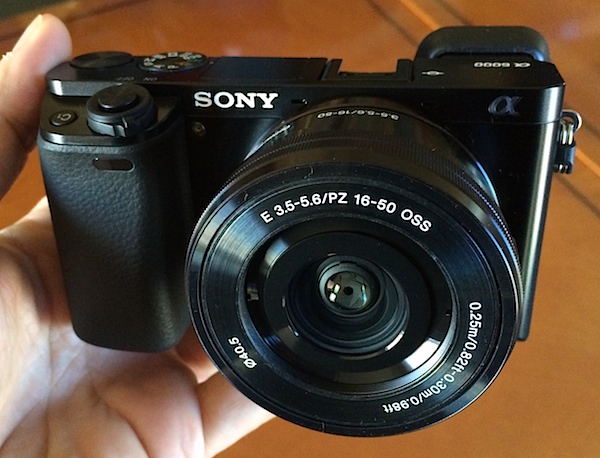Sony Alpha a6000 Could Be Mirrorless Camera for DSLR Switchers
What looks like a minor upgrade to Sony's current consumer mirrorless cameras could have just the right new features to attract DSLR shooters.

What looks like a minor upgrade to Sony's current consumer mirrorless cameras could have just the right new features to attract DSLR shooters.
On the outside, Sony's new Alpha a6000 mirrorless camera is nearly indistinguishable from its predecessors, the NEX-6 and NEX-7. But the combination of a faster autofocusing technology and a relatively low price ($800, with lens) — could make the 20.3-megapixel camera enticing to DSLR users when it goes on sale in April.
Sony claims that, based on its tests, the a6000 has the "world’s fastest autofocus system" for an interchangeable lens camera, at 0.06 seconds. We couldn't begin to test that with the preproduction model we saw. But because of the autofocus technology Sony uses, the claim is at least credible.
MORE: Best Mirrorless Cameras 2014
The a6000 is the latest in a recent crop of mirrorless cameras, including Sony's 16.1-megapixel NEX-6 and the new 20.3MP Samsung NX30, that employ the same autofocus technology, known as phase detection, that is a hallmark of DSLRs. Most mirrorless cameras (and until recently, all of them) use instead the sluggish contrast detection technology that makes point-and-shoot cameras so painfully slow to focus.
Like its new brethren, the a6000 actually uses both phase detection (for speed) and contrast detection (for refinement). The A6000's APS-C size imaging chip (the same size as in most DSLRs) has nearly twice as many phase detection sensors as its predecessor, the NEX-6, does (179 vs. 99) as well as higher resolution.
With the focus sensors right on the imaging chip, mirrorless cameras have a leg up on DLSRs, which have to first focus and then swing the internal mirror used by the viewfinder out of the way to take a photo. The lack of a mirror mechanism also leads to faster continuous shooting: Sony claims 11 frames per second for the Alpha a6000. Canon, for example, claims 5 fps for its $850 (with lens) Digital Rebel T5i DSLR.
Sign up to get the BEST of Tom's Guide direct to your inbox.
Get instant access to breaking news, the hottest reviews, great deals and helpful tips.
The speed, as well as very high light sensitivity capability of ISO 25,000, are likely products of Sony's latest image processor, the Bionz X. (It's the same processor used in Sony's pro-level Alpha a7 and a7R mirrorless cameras.)
Some compromises
The other bonus for DSLR fans is the a6000's 1.4 million-dot OLED viewfinder, which stands in for the optical viewfinder in a DSLR. OLED displays images vividly (compared to most LCD viewfinders). The 1.4-million-dot resolution should provide a good amount of detail, though not as much as the 2.4-million-dot screens in the predecessor NEX-6 and NEX-7 cameras. (The a6000 also has 3-inch tilting LCD screen on the back.)
MORE: 15 Best Photo Editing Apps
The a6000 makes a few other small cutbacks. For instance, while it shoots 1080p video in an array of frame rates and file formats, it lacks an audio input jack for attaching an external microphone. So you are left with the audio that the built-in microphones capture.
The a6000 is tricked out wirelessly. In addition to the nearly obligatory Wi-Fi capabilities of new cameras, it also an NFC chip for one-touch wireless pairing with NFC-equipped Android smartphones and tablets. Sony's iOS and Android Smart Remote Control app provides some remote capabilities like previewing a photo and snapping the shutter.
The $800 kit includes Sony's 16-50mm motorized zoom lens. The camera body only sells for $650 and can take any of the 20 E-Mount Sony lenses that also work with the a7 and a7R cameras.
Follow Sean Captain @seancaptain and on Google+. Follow Tom's Guide at @tomsguide, on Facebook and on Google+.
Sean Captain is a freelance technology and science writer, editor and photographer. At Tom's Guide, he has reviewed cameras, including most of Sony's Alpha A6000-series mirrorless cameras, as well as other photography-related content. He has also written for Fast Company, The New York Times, The Wall Street Journal, and Wired.
-
DIn552 Start working at home with Google! Just work for few hours and have more time with friends and family. I earn up to $500 per week. It's a great work at home opportunity. I can't believe how easy it was once I tried it out. Linked here CapitalPosts.comReply
